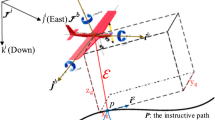Abstract
The combination of pursuit and line of sight guidance laws, called PLOS, is used to steer an unmanned aerial vehicle along a desired path. In the previous studies, the parameters of this guidance law are tuned by trial and error and are constant, during the flight. In this research, it will be shown that the optimal value of these parameters depends on the initial conditions of the problem and the wind conditions. For this reason, a fuzzy system is proposed to generate the instantaneous optimal value of these parameters, in such a way that the flying vehicle converges to the desired path in less time and follows it more accurately, in the presence of wind. For this purpose, a cost function is defined to penalize the distance from the desired path and the control effort. Then, the parameters of the fuzzy system are optimized for different initial and wind conditions. During the flight, the optimized fuzzy systems determine the parameters of the guidance algorithm in an online manner, in such a way that the desired path is better followed. The obtained results show that online adjustment of the PLOS guidance law improves its performance in the presence of wind by about 20%.
Similar content being viewed by others
Data Availability
The codes generated during the current study are available from the corresponding author on reasonable request. All data generated for analysis during this study are included in this published article
All data generated for analyzed during this study are included in this published article.
Javad Asghari]; Writing - original draft preparation: [Javad Asghari]; Writing - review and editing: [Hadi Nobahari]; Supervision: [Hadi Nobahari].
References
Park, S., Deyst, J., How, J.: A new nonlinear guidance logic for trajectory tracking. AIAA Guid, Navig, Control Conf Exhibit. (2004). https://doi.org/10.2514/6.2004-4900
Park, S., Deyst, J., How, J.P.: Performance and lyapunov stability of a nonlinear path following guidance method. J Guidance, Control, Dyn. (2007). https://doi.org/10.2514/1.28957
Nelson, D.R., Blake Barber, D., McLain, T.W., Beard, R.W.: Vector field path following for small unmanned air vehicles. Am Control Conf. (2006). https://doi.org/10.1109/ACC.2006.1657648
Jarrett, C., Perry, K., Stol, K.A.: Controller comparisons for autonomous railway following with a fixed-wing UAV. Int Conf Autom, Robot Appl. (2015). https://doi.org/10.1109/ICARA.2015.7081132
Ratnoo, A., Sujit, P.B., Kothari, M.: Adaptive optimal path following for high wind flights. IFAC Proceed. (2011). https://doi.org/10.3182/20110828-6-IT-1002.03720
Zamurad Shah, M., Samar, R., and Bhatti, A. I.: Lateral control for UAVs using sliding mode technique. IFAC Proc. (2011). https://doi.org/10.1109/ICET.2013.6743506
Kang, Y., Hedrick, J.K.: Linear tracking for a fixed-wing UAV using nonlinear model predictive control. IEEE Trans. Control Syst. Technol. (2009). https://doi.org/10.1007/s13369-017-2881-8
Prodan, I., Bencatel, R., Olaru, S., De Sousa, J. B., Stoica, C., and Niculescu, S. I.: Predictive control for autonomous aerial vehicles trajectory tracking. IFAC Proc. (2012). https://doi.org/10.3182/20120823-5-NL-3013.00078
Zhao, Shulong, et al.: A novel data-driven control for fixed-wing UAV path following. IEEE International Conference on Information and Automation (2015). https://doi.org/10.1007/s10846-017-0472-2
Rucco, A., Pedro Aguiar, A., Pereira, F.L., Borges, J., de Sousa: A predictive path-following approach for fixed-wing unmanned aerial vehicles in presence of wind disturbances. Second Iberian Robot Conf. (2015). https://doi.org/10.1007/978-3-319-27146-048
Gavilan, F., Vazquez, R., Camacho, E.F.: An iterative model predictive control algorithm for UAV guidance. IEEE Trans. Aerosp. Electron. Syst. (2015). https://doi.org/10.1109/TAES.2015.140153
Saurav, R., Sohil, L.D., Ghosh, S.: Variable L1 Guidance Strategy for Path Following of UAVs. Int Conf Unmanned Aircraft Syst. (2020). https://doi.org/10.1109/ICUAS48674.2020.9214056
Singh, M., Manoharan, A., Ratnoo, A., Sujit, P.B.: Three dimensional uav path following using sdre guidance. Int Conf Unmanned Aircraft Syst. (2019). https://doi.org/10.1109/ICUAS.2019.8798259
Kothari, M., Postlethwaite, I., Gu, D.-W.: A Suboptimal Path Planning Algorithm Using Rapidly-Exploring Random. Trees. Int. J. Aerosp, Innov. (2010). https://doi.org/10.1007/978-3-319-61403-84
Sujit, P.B., Saripalli, S., Sousa, J.B.: An evaluation of UAV path following algorithms. Eur Control Conf. (2013). https://doi.org/10.23919/ECC.2013.6669680
Sujit, P.B., Saripalli, S., Sousa, J.B.: Unmanned aerial vehicle path following: A survey and analysis of algorithms for fixed-wing unmanned aerial vehicless. IEEE Control Syst Magaz. (2014). https://doi.org/10.1109/MCS.2013.2287568
Kothari, M., Postlethwaite, I., Gu, D.-W.: UAV path following in windy urban environments. J Intell Robot Syst. (2014). https://doi.org/10.1007/s10846-013-9873-z
Pelizer, G.V., Da Silva, N.B.F., Branco, K.R.L.J.: Comparison of 3D Path-Following Algorithms for Unmanned Aerial Vehicles. Int. Conf. Unmanned Aircr, Syst. (2017). https://doi.org/10.1109/ICUAS.2017.7991338
Xavier, D. M., Silva Natassya, B.F., and Branco Kalinka, R.L.J.C.: Path-following algorithms comparison using Software-in-the-Loop simulations for UAVs. IEEE Symposium on Computers and Communications (2019). https://doi.org/10.1109/ISCC47284.2019.8969604
Karimi, A., Nobahari, H., Siarry, P.: Continuous ant colony system and tabu search algorithms hybridized for global minimization of continuous multi-minima functions. Comput. Optim. Appl. 45, 639–661 (2010). https://doi.org/10.1007/s10589-008-9176-7
Funding
This research received no specific grant from any funding agency in the public, commercial, or not-for-profit sectors.
Author information
Authors and Affiliations
Contributions
Conceptualization: [Hadi Nobahari]; Data curation: [Javad Asghari]; Formal analysis and investigation: [Javad Asghari]; Methodology: [Hadi Nobahari, Javad Asghari]; Software: [Javad Asghari]; Validation: [Hadi Nobahari, Javad Asghari]; Visualization: [Hadi Nobahari,
Corresponding author
Ethics declarations
Ethics Approval
This paper does not contain any studies with human participants or animals performed by any of the authors.
Consent to Participate
Not Applicable.
Consent for Publication
Not Applicable.
Conflict of Interest
The authors declare that they have no conflict of interest.
Additional information
Publisher’s Note
Springer Nature remains neutral with regard to jurisdictional claims in published maps and institutional affiliations.
Rights and permissions
About this article
Cite this article
Nobahari, H., Asghari, J. A Fuzzy-PLOS Guidance Law for Precise Trajectory Tracking of a UAV in the Presence of Wind. J Intell Robot Syst 105, 18 (2022). https://doi.org/10.1007/s10846-022-01635-y
Received:
Accepted:
Published:
DOI: https://doi.org/10.1007/s10846-022-01635-y




